|

 Up
Up

 A Gift to
A Gift to
Remember

(You are here.)
 Down
Down




  Need
to Need
to
find your
bearings?
Try
these
navigation aids:
If
this is your first
visit, please stop by:
Something
to share?
Please:



|
|
Available in Française, Español, Português, Deutsch, Россию,
中文,
日本, and others.
 hile
Cal convalesced in Pasadena, Charlie Taylor and other members of the Vin
Fiz crew rebuilt the airplane. On December 10, with both ankles
encased in plaster casts, Cal Rodgers hobbled out to the gleaming white Vin
Fiz in a field near Compton. He checked that the bottle of Vin Fiz was
secure, lashed his crutches to the struts, and climbed aboard. The crew
swung the propellers, the motor roared to life, and Cal Rodgers flew 12
miles to Long Beach where 50,000 people had assembled to cheer him as he
dipped the wheels of his airplane in the Pacific Ocean. hile
Cal convalesced in Pasadena, Charlie Taylor and other members of the Vin
Fiz crew rebuilt the airplane. On December 10, with both ankles
encased in plaster casts, Cal Rodgers hobbled out to the gleaming white Vin
Fiz in a field near Compton. He checked that the bottle of Vin Fiz was
secure, lashed his crutches to the struts, and climbed aboard. The crew
swung the propellers, the motor roared to life, and Cal Rodgers flew 12
miles to Long Beach where 50,000 people had assembled to cheer him as he
dipped the wheels of his airplane in the Pacific Ocean.
He had flown 4, 231 miles (6809 kilometers) in 84 days, spending 82 hours in the air and
traveling at an average ground speed of 52 miles (84 kilometers) per hour. He had consumed
1,230 gallons (4656 liters) of gasoline, and had replaced every part on his airplane at
least once with the exception of the rudder, the oil drip pan, and a single strut. The
adventure had cost the Armour Meat-Packing Company $180,000. The $50,000
Hearst prize went unclaimed; William Randolph Hearst never even sent the
aviator a note of congratulations. And none of that seemed to matter.
Cal Rodgers had done something important. More to the point, he had
given something important to the thousands of people who watched him fly
and the millions who had followed his flight in the newspapers. Even a
century later, it's hard to explain just what he gave of himself, but it
was undeniably precious when you consider the fervor with which it was
received. Perhaps it's best explained with one last anecdote from the
historic account of the Vin Fiz.
While Cal was laid over in the little whistle stop of Kyle, Texas as
his crew waited for parts to repair the Vin Fiz engine, he had them
assemble a Wright Model B they had brought with them. It was the same
airplane he had bought to make his first solo flight when he couldn't wait
to get into the air. Cal offered to take any of the assembled spectators
aloft for $5. There were no takers. "One dollar?" asked Cal,
incredulous. "Fifty cents? Two bits?" An eleven-year-old boy
stepped out of the crowd and handed Cal a quarter.
Cal hoisted Newt Millhollon into the passenger seat of the Model B and
gave him back his quarter. "This one is a gift," he told the
boy. "A gift of flight — the sky and the wind. You will see your
whole town, the fields around it. You will know a different world. Now
that is a gift to remember."
|
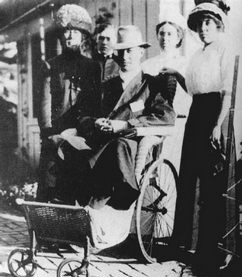
After his crash in Compton, Cal recuperated in Pasadena, nursed
back to health by the attentions of his wife Mabel (right) and his mother
Maria Sweitzer (left).
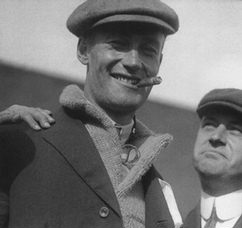
Call Rodgers triumphant at Long Beach.
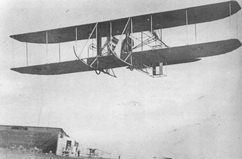
For a time after his transcontinental journey, Cal Rodgers and his
wife Mabel stayed in Pasadena, California. Cal sold rides and gave
demonstration flights in his Wright Model B. He flew for the 1912
Tournament of Roses Parade, dropping flowers from his aircraft.
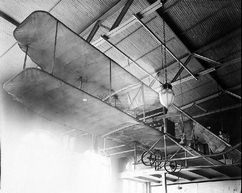
Although no one is quite sure how it got there, the
Vin Fiz or a copy of the
Vin Fiz made from parts that
had been discarded along its transcontinental flight showed up at
the Carnegie Museum (above) in Pittsburg, PA around 1917. This was
given to the Smithsonian in 1934 and fully restored in 1960.
|
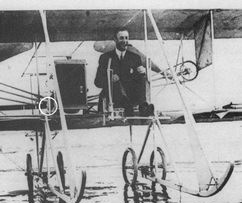
After his final flight on 10 December 1911, Cal Rodgers wets his wheels in the Pacific surf. The
Vin Fiz bottle is in place behind the forward strut to the left of the
radiator.
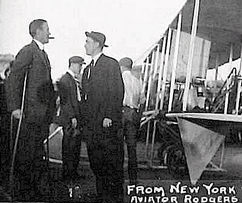
Cal had not yet fully recovered and was still on crutches when he flew
the final leg of the journey.
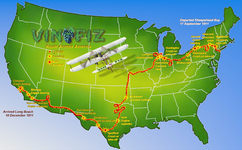
While flying across America, Cal had survived at least 16 accidents,
including 2 engine explosions and 5 wrecks so severe the entire aircraft
had to be rebuilt. When the Vin Fiz
landed at Long Beach, only three original parts remained.
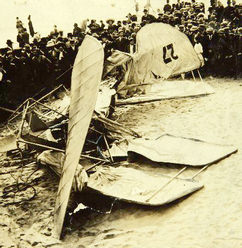
On 3 April 1912, Cal and his Wright Model B tangled with a flock of
seagulls just 100 yards (91 meters) from where he had completed his
flight across America. He lost control, crashed the Model B into the
surf, and was killed.
|